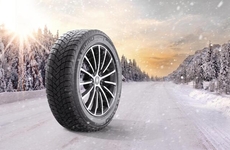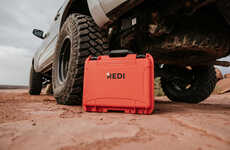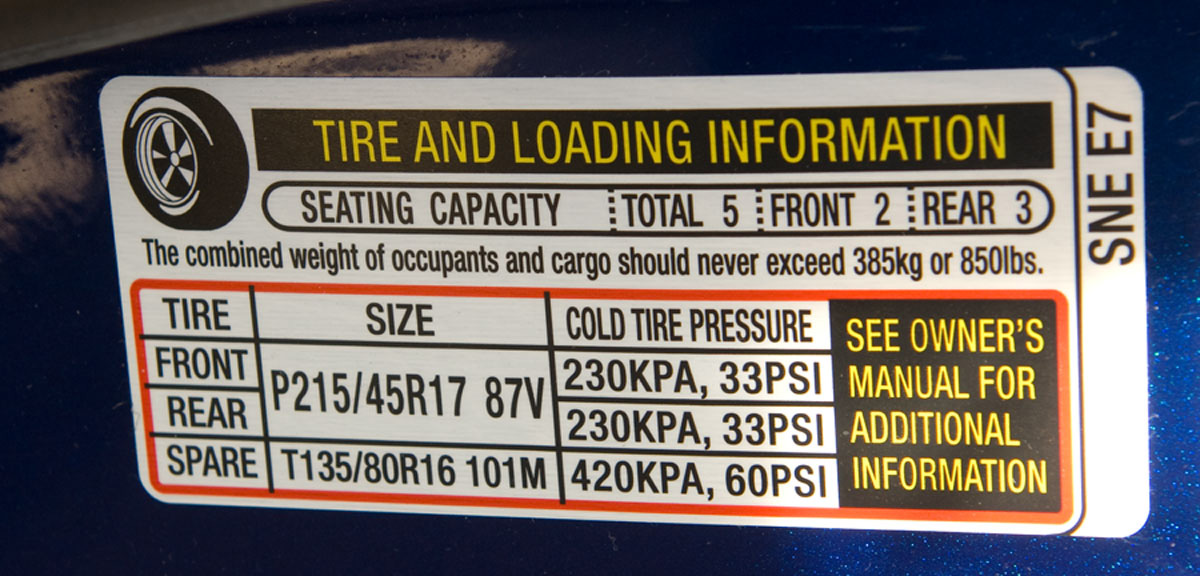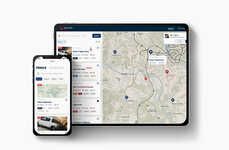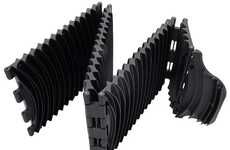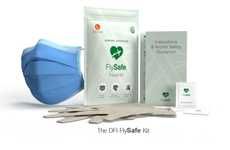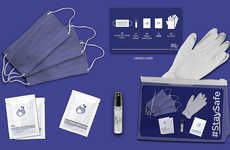
The Essential Road Trip Checklist for Safe Holiday Travel
Trend Hunter — December 14, 2015 — Autos
Brought to you by Tire Rack
Gearing up to hit the road for holiday travel? Whether you plan to see family or drive to a big football game with friends, there’s no doubt you’ll want to be safe. With more people than usual on the road and uncertain conditions, it’s important to take extra precautions during the holidays and winter months. Use this checklist by our friends at TireRack.com for expert advice on what to check before you go.
TIRES
What to Check
Look for signs of wear on your tires, and replace them as needed. For reduced braking distance and maximum control and safety in wintry conditions, make sure to have winter tires equipped. Also, check tire air pressure using a hand-held tire pressure gauge in addition to monitoring your Tire Pressure Monitoring System.
If you’re not sure of the appropriate air pressure for your car, look inside the driver’s doorjamb or your owner’s manual.
Pro Tip
Cans of tire sealant are cheap, compact and simple to use for minor tire issues. They’re not a permanent fix, but they’ll usually get you to safety.
ENGINE & TRANSMISSION
What to Check
Prevent trip-ending engine problems on the highway. Here are some simple tips to get started:
• Check fluid levels including oil, brake, coolant, and windshield washer.
• Fix leaks
• Replace all filters and fluids with manufacturer-specified products.
• Stay up-to-date with mileage-based routine maintenance
• Be sure to check your owner’s manual for more details, such as the recommended maintenance schedule.
BELTS
What to Check
Problems with belt-driven systems such as power steering and alternators can lead to dangerous situations. This is especially true if they fail in solitary areas or poor weather. To make sure your belts are in good condition inspect them for:
• Correct tension
• Excessive cracks
• Missing chunks
• Frays
Pro Tip
If you are unsure of your belt’s condition, have it checked by an ASE Certified Technician. Also, carry a couple extra on your trip.
ELECTRICAL
What to Check
Indicators of electrical problems can include dim lights, a motor that is shuddering a lot, or an electrical system cutting off or functioning abnormally. If you have any of these issues, look for one of the following as a possible cause:
• Blown fuses or relays
• Disconnected, loose or waterlogged plugs
• Exposed or cut wires
Pro Tip
Keep spare fuses and relays on hand by picking up an assortment fuse pack from an auto parts stores. Both knives and pliers can be used for splicing wires and replacing fuses. Use Electrical tape and zip ties for insulating a connection or trying to hold something in its place.
LIGHTING
What to Check
Foggy headlights can make night driving dangerous for obvious reasons. Don’t be the person who can’t see the road ahead because of foggy headlights.
Pro Tip
Pick up a headlight repair kit or polish and a soft cloth to clear foggy headlights, and to improve your night driving experience.
BRAKING SYSTEM
What to Check
Clean brake fluid is paramount for your brake system to work correctly, and new brake pads and rotors are a plus. Check your calipers to make sure they move freely, and look for any suspicious leaks.
SUSPENSION
What to Check
Look after your shocks, bushings, joints, and springs to avoid dangerous accidents. Signs of suspension problems include uncontrolled steering wheel movement, excessive bouncing or swaying while turning or hitting bumps, and a sagging vehicle. Repairing these will give you a better ride and a safer one as well.
PERSONAL SAFETY
The winter is the most dangerous driving time of the year, so be smart on the road. Make sure you get enough sleep, update your GPS and maps, drive cautiously, and stay alert to road conditions. Prepare emergency tools and personal safety kits as well.
Good emergency tool kits have wrenches and sockets for the most common sized bolts on the vehicle, Phillips-head and flathead screwdrivers, a ratchet, a medium hammer, an adjustable wrench, a pair of pressure lock pliers, and a leverage bar. Even if you don’t know how to do some repairs, someone who does may stop to help you.
A basic personal safety kit should include drinking water, nutritious snacks, blankets, portable mobile chargers, a flashlight, and batteries. You can also include hand/feet warmers, glow sticks, and a battery powered AM/FM radio.
No matter the distance, we know that you want to be safe on your holiday trip and we hope you found these tips helpful. For expert advise on tires and car parts for any weather or season, visit TireRack.com. They’ve been helping people find the right tires, wheels, and performance parts since 1979.
Check out the video below for even more great info from Tire Rack.
Gearing up to hit the road for holiday travel? Whether you plan to see family or drive to a big football game with friends, there’s no doubt you’ll want to be safe. With more people than usual on the road and uncertain conditions, it’s important to take extra precautions during the holidays and winter months. Use this checklist by our friends at TireRack.com for expert advice on what to check before you go.
TIRES
What to Check
Look for signs of wear on your tires, and replace them as needed. For reduced braking distance and maximum control and safety in wintry conditions, make sure to have winter tires equipped. Also, check tire air pressure using a hand-held tire pressure gauge in addition to monitoring your Tire Pressure Monitoring System.
If you’re not sure of the appropriate air pressure for your car, look inside the driver’s doorjamb or your owner’s manual.
Pro Tip
Cans of tire sealant are cheap, compact and simple to use for minor tire issues. They’re not a permanent fix, but they’ll usually get you to safety.
ENGINE & TRANSMISSION
What to Check
Prevent trip-ending engine problems on the highway. Here are some simple tips to get started:
• Check fluid levels including oil, brake, coolant, and windshield washer.
• Fix leaks
• Replace all filters and fluids with manufacturer-specified products.
• Stay up-to-date with mileage-based routine maintenance
• Be sure to check your owner’s manual for more details, such as the recommended maintenance schedule.
BELTS
What to Check
Problems with belt-driven systems such as power steering and alternators can lead to dangerous situations. This is especially true if they fail in solitary areas or poor weather. To make sure your belts are in good condition inspect them for:
• Correct tension
• Excessive cracks
• Missing chunks
• Frays
Pro Tip
If you are unsure of your belt’s condition, have it checked by an ASE Certified Technician. Also, carry a couple extra on your trip.
ELECTRICAL
What to Check
Indicators of electrical problems can include dim lights, a motor that is shuddering a lot, or an electrical system cutting off or functioning abnormally. If you have any of these issues, look for one of the following as a possible cause:
• Blown fuses or relays
• Disconnected, loose or waterlogged plugs
• Exposed or cut wires
Pro Tip
Keep spare fuses and relays on hand by picking up an assortment fuse pack from an auto parts stores. Both knives and pliers can be used for splicing wires and replacing fuses. Use Electrical tape and zip ties for insulating a connection or trying to hold something in its place.
LIGHTING
What to Check
Foggy headlights can make night driving dangerous for obvious reasons. Don’t be the person who can’t see the road ahead because of foggy headlights.
Pro Tip
Pick up a headlight repair kit or polish and a soft cloth to clear foggy headlights, and to improve your night driving experience.
BRAKING SYSTEM
What to Check
Clean brake fluid is paramount for your brake system to work correctly, and new brake pads and rotors are a plus. Check your calipers to make sure they move freely, and look for any suspicious leaks.
SUSPENSION
What to Check
Look after your shocks, bushings, joints, and springs to avoid dangerous accidents. Signs of suspension problems include uncontrolled steering wheel movement, excessive bouncing or swaying while turning or hitting bumps, and a sagging vehicle. Repairing these will give you a better ride and a safer one as well.
PERSONAL SAFETY
The winter is the most dangerous driving time of the year, so be smart on the road. Make sure you get enough sleep, update your GPS and maps, drive cautiously, and stay alert to road conditions. Prepare emergency tools and personal safety kits as well.
Good emergency tool kits have wrenches and sockets for the most common sized bolts on the vehicle, Phillips-head and flathead screwdrivers, a ratchet, a medium hammer, an adjustable wrench, a pair of pressure lock pliers, and a leverage bar. Even if you don’t know how to do some repairs, someone who does may stop to help you.
A basic personal safety kit should include drinking water, nutritious snacks, blankets, portable mobile chargers, a flashlight, and batteries. You can also include hand/feet warmers, glow sticks, and a battery powered AM/FM radio.
No matter the distance, we know that you want to be safe on your holiday trip and we hope you found these tips helpful. For expert advise on tires and car parts for any weather or season, visit TireRack.com. They’ve been helping people find the right tires, wheels, and performance parts since 1979.
Check out the video below for even more great info from Tire Rack.
Trend Themes
1. Winter Tires - Disruptive innovation opportunity: Develop more advanced and durable winter tires to improve safety and control in wintry conditions.
2. Engine Maintenance - Disruptive innovation opportunity: Create innovative engine maintenance solutions that help prevent trip-ending engine problems.
3. Electrical Troubleshooting - Disruptive innovation opportunity: Invent advanced electrical troubleshooting tools and systems to quickly identify and address electrical issues in vehicles.
Industry Implications
1. Tire Manufacturing - Disruptive innovation opportunity: Incorporate new technologies and materials to produce more efficient and reliable tires.
2. Automotive Maintenance - Disruptive innovation opportunity: Develop automated maintenance systems that can diagnose and fix common engine and electrical issues.
3. Automotive Parts Retail - Disruptive innovation opportunity: Create online platforms and tools that make it easier for consumers to find and purchase the right car parts for their needs.
6.7
Score
Popularity
Activity
Freshness


